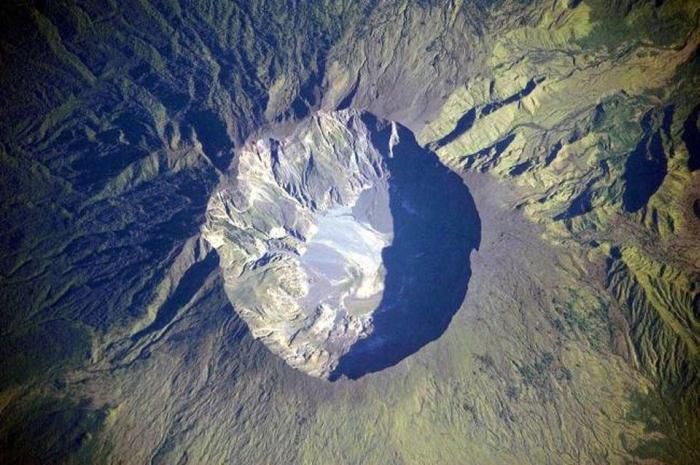
The collapsed Tambora as seen from space.
Wikipedia/NAS
Approximately 20 supervolcanos are known around the world. One of the most famous is the Yellowstone Caldera in the U.S.. Yellowstone is known to have had two VEI 8 eruptions in the past (some 2.1 million and 640,000 years ago). The Volcanic Explosivity Index (VEI) is a relative measure of the explosiveness of a volcanic eruption running from 0 to 8 – the 1980 eruption of Mount St. Helens has a VEI of 5.
A new study, published in the journal Geophysical Research Letters, sheds light over what happens when such a supervolcano erupts, especially its impact on the climate. The researchers tested different volcanic forcing scenarios, lasting several years and with a peak in volcanic emissions. The eruption of a supervolcano can have the power to temporarily change the wind regimes in the tropical stratosphere and change the climate on a global scale.
The question of what happens in the atmosphere when a supervolcano erupts has concerned scientists in atmospheric chemistry and meteorology for a while. Now, an international research team worked together, studying the impact of the supervolcano of Los Chocoyos on Earth’s atmosphere. Los Chocoyos is one of the most recent VEI 8 supereruptions, happening approximately 75,000 years ago in the Guatemalan highlands. Today, the eruption site is an enormous lake, the Atitlán Caldera, surrounded by three cone-shaped volcanoes: the Atitlán, the Tolimán, and the San Pedro.
The eruption forming lake Atitlán was one of the largest volcanic events of the past 100,000 years. Volcanic ash is found in several places in the Guatemalan highlands and in marine deposits from deep-sea cores in the Pacific, the Mexico Gulf and even in the Atlantic Ocean. Based on the chemical composition of ash layers, the eruption also emitted enormous amounts of sulfur, chlorine, and bromine into the atmosphere.
The researchers simulated the impact of a Los Chocoyos-like eruption on the climate using modern climate models, considering the effects of huge amounts of gas and ash emissions to the atmosphere. The volcanic emissions would have multidecadal consequences, blocking the sunlight and cooling parts of Earth’s surface.
Of special interest was the effect the emission would have on the Quasi‐Biennial Oscillation (QBO), an alternating change of wind directions in the stratosphere in the tropics.
The stratosphere is the second major layer of Earth’s atmosphere. The bottom of the stratosphere is around 10 kilometers (6.2 miles or about 33,000 feet) above the ground at middle latitudes. The top of the stratosphere occurs at an altitude of 50 kilometers (31 miles). The stratosphere plays an important role in global wind patterns, but due to the lack of vertical convection in the stratosphere, materials that get into the stratosphere – like volcanic ash and gases – can stay there for long times.
A Los Chocoyos-like eruption is powerful enough to directly inject volcanic sulfur and halogens into the higher stratosphere, leading to sulfuric acid droplet formation and ozone depletion impacting atmospheric radiation and dynamics which disturb the QBO wind system.

The eruption of Mount Redoubt, Alaska, April 21, 1990. Eruption columns over 6 miles high break … [+]
J. Warren/USGS
“An eruption at this dimension would supply amounts of aerosols and chemistry components to the atmosphere, and according to our model simulations, the eruption would cause a 10-year disruption of the QBO wind,” says Kirstin Krüger, author of the study. “The change in the QBO would have started 4 months post-eruption, with abnormal easterly winds lasting for five years, followed by westerlies wind, before it returned to normal QBO conditions, but with a slightly prolonged periodicity.”
Today the Quasi-Biennial Oscillation influences the monsoon precipitation and the atmospheric circulation in the northern hemisphere during winter. Eastward phases of the QBO often coincide with more sudden stratospheric warmings, a weaker Atlantic jet stream and cold winters in Northern Europe and eastern USA whereas westward phases of the QBO often coincide with mild winters in eastern USA and a strong Atlantic jet stream with mild, wet stormy winters in northern Europe. In addition, the QBO has been shown to affect hurricane frequency during hurricane seasons in the Atlantic. Research has also been conducted investigating a possible relationship between ENSO (the El Niño–Southern Oscillation is an irregular periodic variation in winds and sea surface temperatures over the tropical eastern Pacific Ocean) and the QBO. The Los Chocoyos supereruption likely had similar effects. The researchers are now searching for changing climate patterns that can be linked to the time of the eruption to test their model.
This article is auto-generated by Algorithm Source: www.forbes.com


